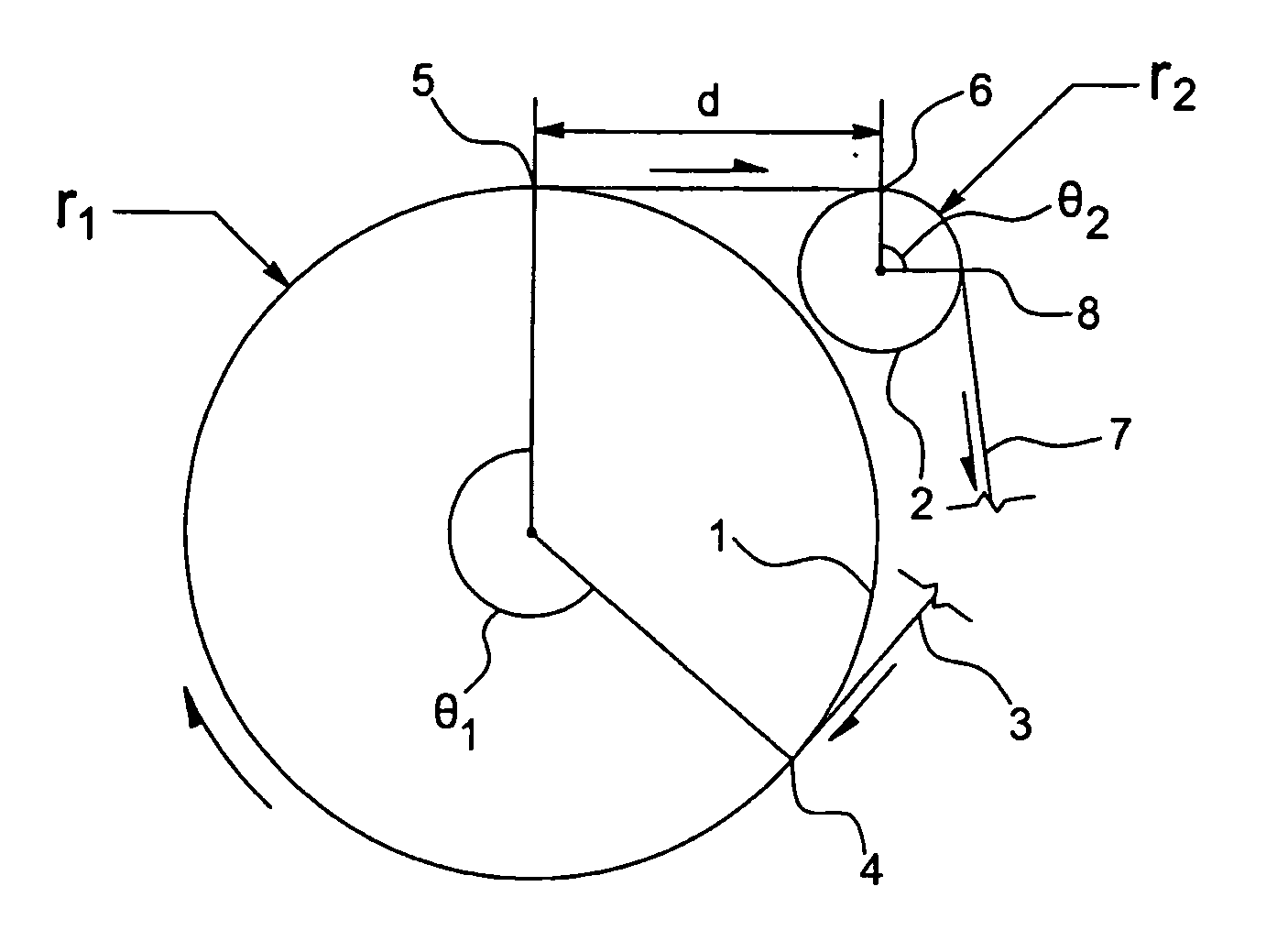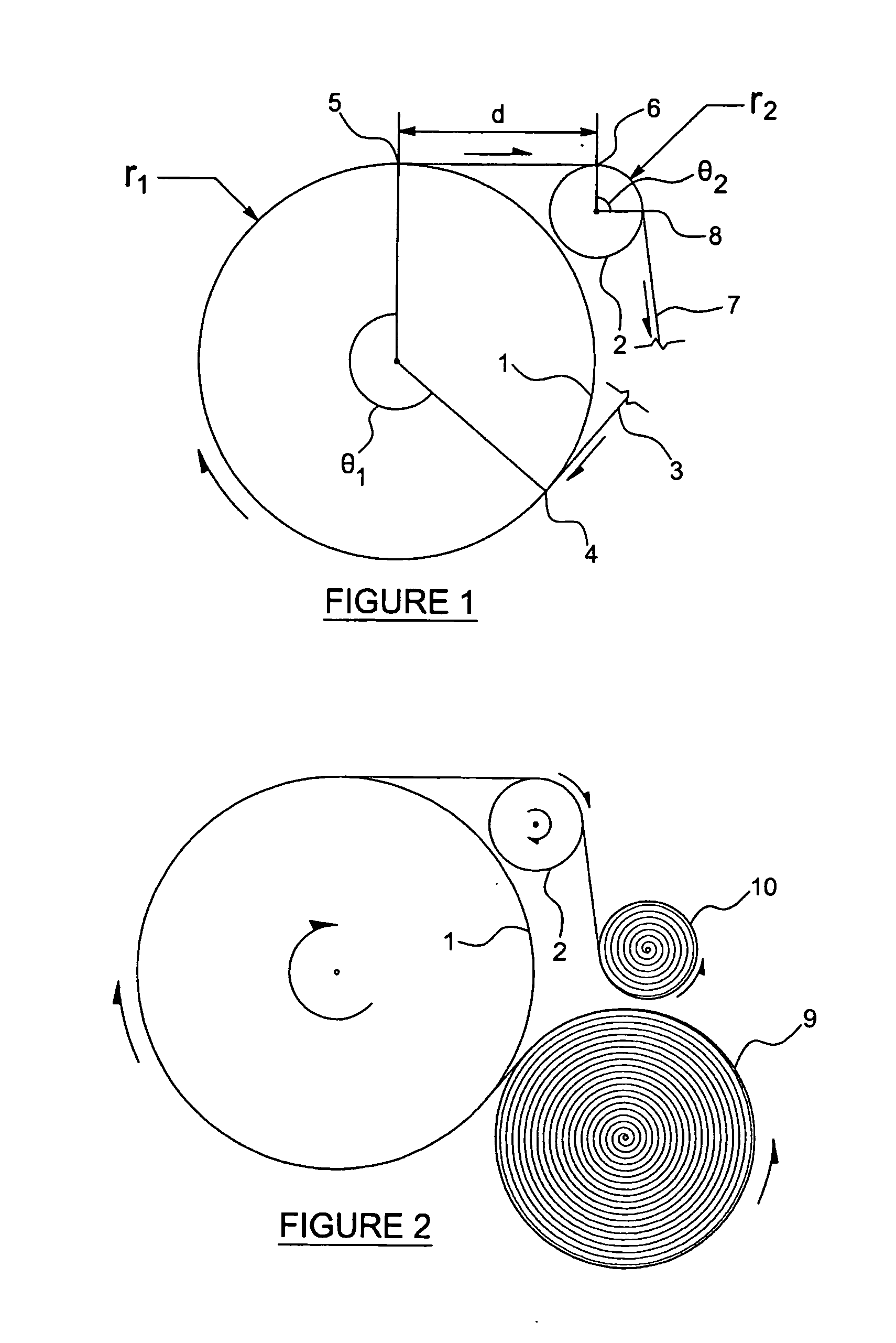System and method for treating an amorphous alloy ribbon
a technology of amorphous alloys and ribbons, applied in the field of amorphous materials, can solve the problems of reducing the attractiveness of alloys, amorphous alloys producing about one third of the core loss of silicon steels, and the production of amorphous alloys is limited to a very thin ribbon of various widths, so as to increase or reduce tensile stress
- Summary
- Abstract
- Description
- Claims
- Application Information
AI Technical Summary
Benefits of technology
Problems solved by technology
Method used
Image
Examples
example 1
[0208]Material: Metglas 2605SA1
[0209]Ribbon feeding rate: 2.0 meters / sec
[0210]Ribbon applied tensile stress: 100 MPa
[0211]No pre-heating
[0212]Treatment temperature: 480° C.
[0213]Natural bending radius after treatment: between 3.0″ to 3.5″
[0214]Ribbon rolled up tensile stress: 5 MPa
[0215]Core weight: 1.04 kg (excluding hub)
[0216]Core inner diameter: 5.80 inches (excluding hub)
[0217]Core outer diameter: 6.83 inches
[0218]Core loss @ 1.3 Tesla, 60 Hz: 0.20 W / kg
[0219]Exciting power @ 1.3 Tesla, 60 Hz: 1.76 VA / kg
[0220]Peak magnetic field @ 1.3 Tesla, 60 Hz: 80 A / m
[0221]B80: 1.3 Tesla
[0222]B80 / Bsat: 0.83
example 2
[0223]Material: Metglas 2605SA1
[0224]Ribbon feeding rate: 5.0 meters / sec
[0225]Ribbon applied tensile stress: 100 MPa
[0226]Pre-heating angle θ3: near 180 degrees
[0227]Pre-heating roller temperature: 485° C.
[0228]Treatment temperature: 485° C.
[0229]Natural bending radius after treatment: between 3.0″ to 3.5″
[0230]Ribbon rolled up tensile stress: 5 MPa
[0231]Core weight: 1.04 kg (excluding hub)
[0232]Core inner diameter: 5.80 inches (excluding hub)
[0233]Core outer diameter: 6.83 inches
[0234]Core loss @ 1.3 Tesla, 60 Hz: 0.20 W / kg
[0235]Exciting power @ 1.3 Tesla, 60 Hz: 2.37 VA / kg
[0236]Peak magnetic field @ 1.3 Tesla, 60 Hz: 97 A / m
[0237]B80: 1.27 Tesla
[0238]B80 / Bsat: 0.81
example 3
[0239]Material: Metglas 2605HB1
[0240]Ribbon feeding rate: 2.0 meters / sec
[0241]Ribbon treatment applied tensile stress: 75 MPa
[0242]Treatment temperature: 455° C.
[0243]No pre-heating
[0244]Natural bending radius after treatment: between 3.0″ to 3.5″
[0245]Ribbon rolled up tensile stress: 5 MPa
[0246]Core weight: 1.04 kg (excluding hub)
[0247]Core inner diameter: 5.80 inches (excluding hub)
[0248]Core outer diameter: 6.83 inches
[0249]Core loss @ 1.3 Tesla, 60 Hz: 0.14 W / kg
[0250]Exciting power @ 1.3 Tesla, 60 Hz: 0.19 VA / kg
[0251]Peak magnetic field @ 1.3 Tesla, 60 Hz: 6.6 A / m
[0252]Core loss @ 1.4 Tesla, 60 Hz: 0.18 W / kg
[0253]Exciting power @ 1.4 Tesla, 60 Hz: 0.35 VA / kg
[0254]Peak magnetic field @ 1.3 Tesla, 60 Hz: 16.2 Nm
[0255]Core loss @ 1.5 Tesla, 60 Hz: 0.22 W / kg
[0256]Exciting power @ 1.5 Tesla, 60 Hz: 1.56 VA / kg
[0257]Peak magnetic field @ 1.3 Tesla, 60 Hz: 80 A / m
[0258]B80: 1.5 Tesla
[0259]B80 / Bsat t: 0.91
PUM
| Property | Measurement | Unit |
|---|---|---|
| speeds | aaaaa | aaaaa |
| temperature | aaaaa | aaaaa |
| temperature | aaaaa | aaaaa |
Abstract
Description
Claims
Application Information
 Login to View More
Login to View More - R&D
- Intellectual Property
- Life Sciences
- Materials
- Tech Scout
- Unparalleled Data Quality
- Higher Quality Content
- 60% Fewer Hallucinations
Browse by: Latest US Patents, China's latest patents, Technical Efficacy Thesaurus, Application Domain, Technology Topic, Popular Technical Reports.
© 2025 PatSnap. All rights reserved.Legal|Privacy policy|Modern Slavery Act Transparency Statement|Sitemap|About US| Contact US: help@patsnap.com



